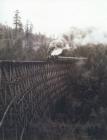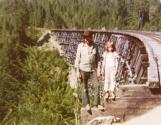1
"Inspiration" is defined as "the drawing in of breath" but most us assign a more common meaning to this word: a burst of unconscious creativity or divine influence. In ancient times, the "breath of the gods" was believed to breathe new life into something. The iconic Kinsol Trestle received a new lease on life - whether through advocacy, technical expertise or political will, people changed the fate of the trestle from one of demolition to rehabilitation.The fate of the Kinsol Trestle has been discussed in the media since 1979, inspiring many Vancouver Islanders and visitors from around the world to see it for themselves. Visitors to the trestle are captivated by the sight of a wooden bridge of this magnitude emerging from the forest and quickly realize that the photos that accompany news stories don't do the bridge justice. The trestle has been the subject of thousands of photographs by both amateurs and professionals. The trestle became a popular destination for families and hikers. After it was abandoned as a working railway, visitors could linger on the bridge without the threat of an oncoming train.
Prior to the rehabilitation, the trestle developed distinct qualities that evolved in the absence of maintenance for nearly three decades. A sublime quality was suggested by the patina of weathered wood, the fallen timbers and an appearance of vulnerability. Conversely, it suggests grandeur and power, and inspires awe. A rehabilitated trestle will retain some of the charm and character of the original bridge.
The Kinsol Trestle has long been an inspiration to people who have an interest in all things that have to do with the railway. In 1954, an excursion train for the National Model Railway Convention made its way from Victoria to the Cowichan Valley. The highlight of this special trip was crossing the Kinsol Trestle and stopping on the north side so that passengers could disembark and take pictures. This was the only true passenger train to cross the trestle. CN was asked to bring passenger cars to Vancouver Island from the mainland by barge for the event. Train enthusiasts like Elwood White, David Wilkie, Stan Owens, and his brother Bill Owens took photographs of the excursion train. Stan's wife, Mary Owens, remembers how much Stan and Bill enjoyed taking pictures of trains and said, "They were real train fans. They knew David Wilkie well and used to visit back and forth."
2
Special excursion train for National Model Railway convention1954-Sep-04
Kinsol Trestle, Cowichan Valley, Vancouver Island, BC Canada
 Credits:
Credits:Elwood White, Photographer
3
In October 2006, the Cowichan Valley Museum & Archives held a "Trestle Building Competition" - a program designed to raise children's awareness about the importance of our built heritage. Once the model trestles arrived at the museum, an engineer judged the entries. It was a great way to reward the children's efforts to create models inspired by a historical artefact that exists in their own backyard.In January 2007, with interest still high in the fate of the Kinsol Trestle, the museum also held an art exhibition called "Kinsol: An Inspiration". Entries for the show arrived from around Vancouver Island. The trestle was represented in a variety of media, including oil, watercolour, photography and even music.
The Kinsol Trestle inspires people to compose music, write letters, sign petitions, and build models. It has also led many people to consider the importance of heritage.
AUDIO: Gordon Macdonald
...one of the real pleasures of working in conservation in North America is that the structures, the buildings that we work with, the objects, they're not terribly old, and so, there are couple of benefits to that. One is usually a pretty good documentary and photographic record, if one takes the time to dig deep enough. And secondly, it's possible to still connect with some of the people who had practical, on-the-ground experience of these places, and that's exactly the case with Ralph. Ralph was the Senior Bridge engineer for CN, Western Mountain region, for years. He served his whole career with CN, and the Kinsol was, I think, really the feather in his cap, he's very fond of it, among some two thousand bridges that he was responsible for, two or three thousand bridges, some fantastic number. Anyway, we early on made contact with Ralph through Cowichan Valley Archive. We discovered that there were some photographs and some early copies of the CN files. Ralph steered us toward the Museum and Archives, and then we hooked up with Ralph at the first opportunity after that. That was just enormously enjoyable, as well as being a wealth of new information...we've stayed in constant touch with him, we have done ever since the project began. In many respects those of us who are working on the bridge feel like Ralph is the real client; that we're there to sort of meet the expectations of. Of course on a practical level we deal with the CVRD and we always have the MOTI keeping a watch..., but it feels, in a really down-to-earth sort of way, like Ralph is the real client here.
4
Gordon Macdonald speaks of Ralph Morris' contributions26 November 2010
Kinsol Trestle, Cowichan Valley, Vancouver Island, BC Canada
 Credits:
Credits:Gordon Macdonald, Speaker, Macdonald & Lawrence Timber Framing
Cowichan Valley Musuem & Archives
5
Small visitor to TrestleJune 1984
Kinsol Trestle, Cowichan Valley, Vancouver Island, BC Canada
 Credits:
Credits:Cowichan Valley Museum & Archives
Gibson Family
6
Perhaps one of the most exciting legacies of the rehabilitation of the trestle is that the campaign to save it has raised awareness of heritage conservation in the community. Many who had initially opposed the idea of rehabilitating the trestle soon changed their minds. Recognition of the importance of the built environment is a wonderful outcome of this heritage rehabilitation story. Hopefully, future generations will embrace their inheritance of structures like the Kinsol Trestle.Children became inspired by the campaign to save the old railway bridge. Two young people, Tiffany Weatherston and Pierre Recevaux, wrote a letter to a local newspaper imploring the CVRD to intervene in the demolition of the trestle. They wrote, "We believe that it is important to keep the history of the Cowichan Valley alive so that future children will be able to experience history for themselves. Please, Mr. CVRD, whoever you are, do not tear down the Kinsol Trestle."
7
Marlene Spaeth and relative on precarious perch6 July 1975
Kinsol Trestle, Cowichan Valley, Vancouver Island, BC Canada
 Credits:
Credits:Cowichan Valley Museum & Archives
Marlene Spaeth